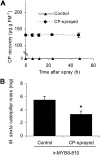R2R3-NaMYB8 regulates the accumulation of phenylpropanoid-polyamine conjugates, which are essential for local and systemic defense against insect herbivores in Nicotiana attenuata
- PMID: 20089770
- PMCID: PMC2832263
- DOI: 10.1104/pp.109.151738
R2R3-NaMYB8 regulates the accumulation of phenylpropanoid-polyamine conjugates, which are essential for local and systemic defense against insect herbivores in Nicotiana attenuata
Abstract
Although phenylpropanoid-polyamine conjugates (PPCs) occur ubiquitously in plants, their biological roles remain largely unexplored. The two major PPCs of Nicotiana attenuata plants, caffeoylputrescine (CP) and dicaffeoylspermidine, increase dramatically in local and systemic tissues after herbivore attack and simulations thereof. We identified NaMYB8, a homolog of NtMYBJS1, which in BY-2 cells regulates PPC biosynthesis, and silenced its expression by RNA interference in N. attenuata (ir-MYB8), to understand the ecological role(s) of PPCs. The regulatory role of NaMYB8 in PPC biosynthesis was validated by a microarray analysis, which revealed that transcripts of several key biosynthetic genes in shikimate and polyamine metabolism accumulated in a NaMYB8-dependent manner. Wild-type N. attenuata plants typically contain high levels of PPCs in their reproductive tissues; however, NaMYB8-silenced plants that completely lacked CP and dicaffeoylspermidine showed no changes in reproductive parameters of the plants. In contrast, a defensive role for PPCs was clear; both specialist (Manduca sexta) and generalist (Spodoptera littoralis) caterpillars feeding on systemically preinduced young stem leaves performed significantly better on ir-MYB8 plants lacking PPCs compared with wild-type plants expressing high levels of PPCs. Moreover, the growth of M. sexta caterpillars was significantly reduced when neonates were fed ir-MYB8 leaves sprayed with synthetic CP, corroborating the role of PPCs as direct plant defense. The spatiotemporal accumulation and function of PPCs in N. attenuata are consistent with the predictions of the optimal defense theory: plants preferentially protect their most fitness-enhancing and vulnerable parts, young tissues and reproductive organs, to maximize their fitness.
Figures







Similar articles
-
The HERBIVORE ELICITOR-REGULATED1 gene enhances abscisic acid levels and defenses against herbivores in Nicotiana attenuata plants.Plant Physiol. 2013 Aug;162(4):2106-24. doi: 10.1104/pp.113.221150. Epub 2013 Jun 19. Plant Physiol. 2013. PMID: 23784463 Free PMC article.
-
Alternative oxidase in resistance to biotic stresses: Nicotiana attenuata AOX contributes to resistance to a pathogen and a piercing-sucking insect but not Manduca sexta larvae.Plant Physiol. 2012 Nov;160(3):1453-67. doi: 10.1104/pp.112.200865. Epub 2012 Sep 7. Plant Physiol. 2012. PMID: 22961128 Free PMC article.
-
Host-plant-mediated effects of Nadefensin on herbivore and pathogen resistance in Nicotiana attenuata.BMC Plant Biol. 2008 Oct 25;8:109. doi: 10.1186/1471-2229-8-109. BMC Plant Biol. 2008. PMID: 18950524 Free PMC article.
-
The essential role of jasmonic acid in plant-herbivore interactions--using the wild tobacco Nicotiana attenuata as a model.J Genet Genomics. 2013 Dec 20;40(12):597-606. doi: 10.1016/j.jgg.2013.10.001. Epub 2013 Nov 9. J Genet Genomics. 2013. PMID: 24377866 Review.
-
Revealing insect herbivory-induced phenolamide metabolism: from single genes to metabolic network plasticity analysis.Plant J. 2014 Aug;79(4):679-92. doi: 10.1111/tpj.12503. Epub 2014 May 21. Plant J. 2014. PMID: 24617849 Free PMC article. Review.
Cited by
-
Genome-Wide Analysis Reveals Transcription Factors Regulated by Spider-Mite Feeding in Cucumber (Cucumis sativus).Plants (Basel). 2020 Aug 11;9(8):1014. doi: 10.3390/plants9081014. Plants (Basel). 2020. PMID: 32796676 Free PMC article.
-
Comparative TMT Proteomic Analysis Unveils Unique Insights into Helicoverpa armigera (Hübner) Resistance in Cajanus scarabaeoides (L.) Thouars.Int J Mol Sci. 2021 May 31;22(11):5941. doi: 10.3390/ijms22115941. Int J Mol Sci. 2021. PMID: 34073052 Free PMC article.
-
Small Brown Planthopper Nymph Infestation Regulates Plant Defenses by Affecting Secondary Metabolite Biosynthesis in Rice.Int J Mol Sci. 2023 Mar 1;24(5):4764. doi: 10.3390/ijms24054764. Int J Mol Sci. 2023. PMID: 36902211 Free PMC article.
-
Chitooligosaccharide elicitor and oxylipins synergistically elevate phytoalexin production in rice.Plant Mol Biol. 2022 Jul;109(4-5):595-609. doi: 10.1007/s11103-021-01217-w. Epub 2021 Nov 25. Plant Mol Biol. 2022. PMID: 34822009
-
Rice phenolamindes reduce the survival of female adults of the white-backed planthopper Sogatella furcifera.Sci Rep. 2020 Apr 1;10(1):5778. doi: 10.1038/s41598-020-62752-y. Sci Rep. 2020. PMID: 32238850 Free PMC article.
References
-
- Balint R, Cooper G, Staebell M, Filner P. (1987) N-Caffeoyl-4-amino-n-butyric acid, a new flower-specific metabolite in cultured tobacco cells and tobacco plants. J Biol Chem 262: 11026–11031 - PubMed
-
- Baumann K, Perez-Rodriguez M, Bradley D, Venail J, Bailey P, Jin H, Koes R, Roberts K, Martin C. (2007) Control of cell and petal morphogenesis by R2R3 MYB transcription factors. Development 134: 1691–1701 - PubMed
-
- Boege K, Dirzo R, Siemens D, Brown P. (2007) Ontogenetic switches from plant resistance to tolerance: minimizing costs with age?. Ecol Lett 10: 177–187 - PubMed
-
- Boege K, Marquis RJ. (2005) Facing herbivory as you grow up: the ontogeny of resistance in plants. Trends Ecol Evol 20: 441–448 - PubMed
Publication types
MeSH terms
Substances
LinkOut - more resources
Full Text Sources
Miscellaneous

